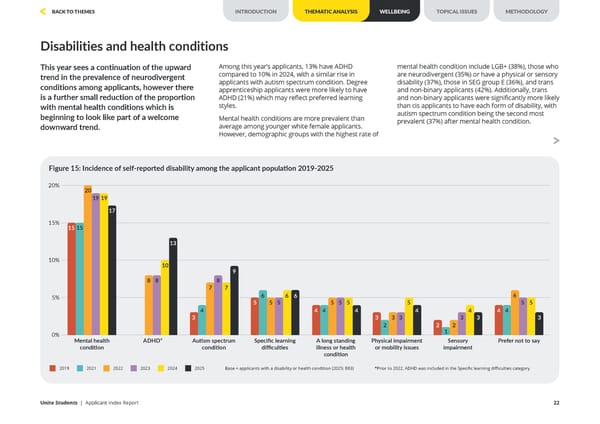Disabilities and health conditions This year sees a continuation of the upward trend in the prevalence of neurodivergent conditions among applicants, however there is a further small reduction of the proportion with mental health conditions which is beginning to look like part of a welcome downward trend. Among this year’s applicants, 13% have ADHD compared to 10% in 2024, with a similar rise in applicants with autism spectrum condition. Degree apprenticeship applicants were more likely to have ADHD (21%) which may reflect preferred learning styles. Mental health conditions are more prevalent than average among younger white female applicants. However, demographic groups with the highest rate of mental health condition include LGB+ (38%), those who are neurodivergent (35%) or have a physical or sensory disability (37%), those in SEG group E (36%), and trans and non-binary applicants (42%). Additionally, trans and non-binary applicants were significantly more likely than cis applicants to have each form of disability, with autism spectrum condition being the second most prevalent (37%) after mental health condition. 20% 15% 10% 5% 0% Mental health condition Autism spectrum condition A long standing illness or health condition Physical impairment or mobility issues Sensory impairment Prefer not to say Specific learning difficulties ADHD* 15 17 13 9 3 3 3 3 3 3 2 2 1 2 3 5 5 5 5 5 5 5 5 6 5 15 8 4 4 4 4 4 4 4 4 6 6 6 7 7 8 8 10 19 19 20 2021 2022 2023 2024 2025 Figure 15: Incidence of self-reported disability among the applicant population 2019-2025 2019 Base = applicants with a disability or health condition (2025: 883) *Prior to 2022, ADHD was included in the Specific learning difficulties category Unite Students | Applicant Index Report 22 INTRODUCTION THEMATIC ANALYSIS WELLBEING METHODOLOGY TOPICAL ISSUES BACK TO THEMES
 Unite Students Applicant Index - 2025 Page 21 Page 23
Unite Students Applicant Index - 2025 Page 21 Page 23